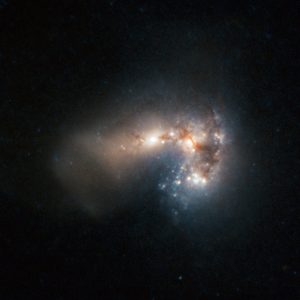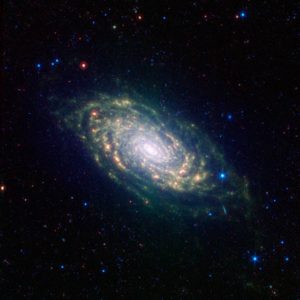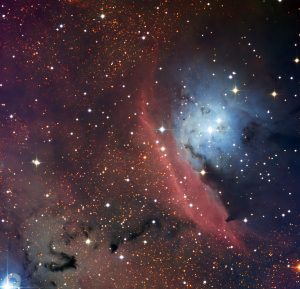Immagini
Frenetica formazione stellare in Haro 11

Sembra una luce delicata quella che pervade Haro 11, tra nubi di gas e polveri, ma questa placida facciata non rispecchia l’eccezionale tasso di formazione stellare che si verifica in questa galassia “starburst”. Continua a leggere
La Galassia Girasole brilla in luce infrarossa

I vari segmenti dei bracci di spirale della Galassia Girasole (Sunflower Galaxy), nota anche come Messier 63, risplendono chiaramente in questa immagine ripresa in luce infrarossa dal telescopio spaziale Spitzer della NASA. La luce infrarossa è sensibile alle strisce di polvere, che appaiono oscure nelle riprese in luce visibile. L’immagine rivela strutture complesse che percorrono la spirale della galassia. Messier 63 si trova a circa 37 milioni di anni luce di distanza, non lontano dalla ben nota Galassia Vortice (Whirlpool Galaxy). Continua a leggere
Rose nei cieli australi

Le due più note galassie satelliti della Via Lattea, le Nubi di Magellano, nel cielo australe, ospitano numerosi giganteschi complessi nebulari, con stelle molto calde e luminose le cui intense radiazioni ultraviolette fanno brillare il gas interstellare circostante. Continua a leggere
Nursery stellare in NGC 1672

Questa immagine mozzafiato della galassia a spirale barrata NGC 1672 consente di ammirare la grande barra della galassia, le vaste regioni di formazione stellare e le fasce oscure di polvere interstellare. Continua a leggere
Una nebulosa ricca di azoto

Questa immagine di Hubble mostra una nebulosa planetaria chiamata NGC 6153, situata a circa 4000 anni luce di distanza nella costellazione dello Scorpione. La debole foschia blu presente in tutta l’inquadratura mostra ciò che resta di una stella simile al Sole dopo che ha esaurito la maggior parte del suo combustibile. Continua a leggere
Una galassia starburst molto speciale

Questa immagine è stata ripresa dall’Advanced Camera for Surveys (ACS) a bordo del telescopio Hubble e mostra una galassia starburst dal nome MCG + 07-33-027.
La galassia si trova a circa 300 milioni di anni luce di distanza dalla Terra e presenta un tasso straordinariamente elevato di formazione stellare. Continua a leggere
La regione di formazione stellare S106

L’immagine del telescopio Hubble mostra Sh 2-106, o S106 in breve. Si tratta di una compatta regione nebulare di formazione stellare nella costellazione del Cigno a quasi 2000 anni luce da noi.
Una giovane stella denominata S106 IR è avvolta nella polvere al centro dell’immagine, ed è responsabile della struttura simile a clessidra della nube gassosa circostante e della turbolenza visibile all’interno. Continua a leggere
Una complessa regione di formazione stellare

Il telescopio Danish situato all’Osservatorio dell’ESO a La Silla, in Cile, ha ripreso una suggestiva immagine di NGC 6559, un oggetto che evidenzia l’anarchia che regna quando si formano stelle all’interno di una nube interstellare. Continua a leggere
La galassia dispersa nello spazio

La maggior parte delle galassie stanno insieme in gruppi o ammassi. Una galassia vicina non si trova mai molto lontano. Ma questa galassia, nota come NGC 6503, risiede invece in una posizione solitaria, al limite di una zona stranamente vuota dello spazio chiamata Vuoto Locale. Continua a leggere
Le nubi scolpite di Eta Carinae

Le stelle massicce possono creare scompiglio nell’ambiente circostante, come si può vedere in questa immagine della nebulosa della Carena ripresa dal telescopio spaziale Spitzer. La stella brillante al centro della nebulosa è Eta Carinae, una delle stelle più massicce della galassia. Il suo bagliore accecante scolpisce e distrugge la nebulosa circostante. Continua a leggere